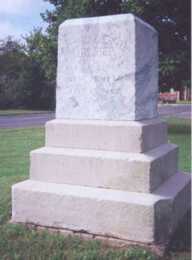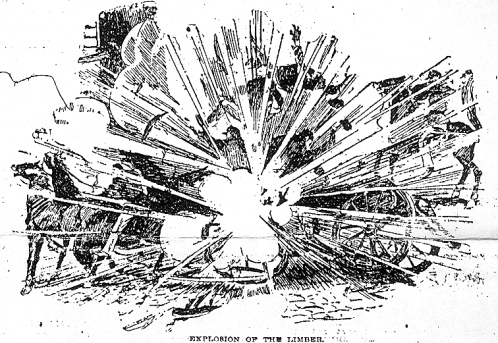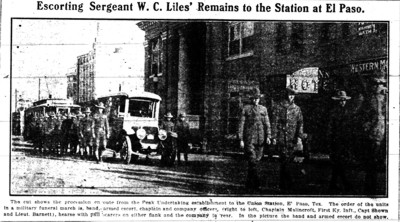1917-1918
Private Almyr Sherrell Edwards

Private Almyr Sherrell Edwards Memorial in Paducah
Private Almyr Sherrell Edwards of Company G, 3rd Regiment Kentucky State Guard died July 13, 1892 while on state active duty. His unit activated on 11 July 1892 at the request of the mayor of Paducah in response to a riot by an armed group of citizens intent on freeing a suspect from the local jail, On 11 July 1892 an African American, Thomas Burgess, was arrested on charges of being a of being a "sneak thief" (burglar). The African American community believed that this individual was going to unfairly convicted, and a group tried to release him from the jail dispersing once during daylight hours peaceably and returning near midnight, armed, and then commenced firing on the jail and the guardsman who were defending it. During short firefight, Private Edwards was mortally wounded. Newspaper accounts of the time reflect a tense state of race relations during these events in Paducah. A monument in honor of Edwards was dedicated on July 13, 1893. The monument was believed to have been moved to its current location after the 1939 floods and it is now located in Caldwell Park at 14th & Park Ave in Paducah.
Corporal Arthur L. Robinson
Private Charles Biechner
Private Archibald McBride
Private Charles C. Woods
Mr. William Adams, Sr. (Civilian Employee)

1895 Louisville Legion Artillery Explosion artwork.
On September 11, 1895, two cannon crews of Battery A, 1st Regiment of the Kentucky State Guard, known as the Louisville Legion were dispatched from the downtown Louisville armory to Phoenix Hill Park to fire a 44 gun salute at sunrise to awaken the city as a part of the festivities for the 29th Encampment of the Grand Army of the Republic (GAR). Each cannon was to fire 22 times. When the second caisson, which was 15 minutes behind the first, reached 4th and Broadway at 5:30 a.m. an explosion occurred. Forty-four bags of carefully packed black powder; each weighing 1.5 lbs., mysteriously ignited. The result was five men and two horses killed several people injured and property damage to buildings in the area. Those killed were Corporal Arthur Langan Robinson, age 26 of 2233 Grayson (Cedar) Street. Private Charles Brechner (Biechner), 24 of 1534 Grayson (Cedar) Street. Private Charles C. Woods, 20 of 1031 Vine Street. Private Archibald McBride, 16 of 625 West Chestnut Street and a civilian, Mr. William Adams Sr., an African-American was also killed in the explosion. Mr. Adams had been hired by the officers of the Louisville Legion to drive the caisson to Phoenix Hill.
For more information see: A Distressing Accident (1895)
Private Robert Edward Diamond

Private Robert Edward Diamond's headstone
Private Robert Edward Diamond, 22, of Lexington (Fayette County) a member of Company A, (Bradley Light Guards), 2nd Kentucky Infantry Regiment Lexington died of his wounds on July 17, 1898. Diamond was accidentally shot while on picket duty in Mayfield on 7 July 1898 while his unit guarding prisoner Bob Blanks who was standing trial in a high profile case and was in danger of being lynched. A fellow soldier, Louis Fischer, chambered a round in his gun as he was nearing his duty station in the picket line when the round accidentally discharged going through Diamond's arm and shattering bone. Diamond was returned to Lexington under the care of a doctor and admitted to the Protestant Infirmary where he later died of complications on July 17, 1898. Diamond had also served with his unit on federal active duty during the Spanish American War. Diamond was laid to rest on July 18, 1898 in Section D, Lot 75 of the Lexington Cemetery. Diamond's grave became unmarked at some point in the intervening years until discovered by John A. Mills III and the Sgt. Elijah P. Marrs Camp #5 The Sons of Union Veterans of the Civil War who placed a new government headstone on his grave unveiling it during a ceremony in November 2005.
Private Kenneth Witty
Private Kenneth Witty of Hopkinsville, Christian County, died while on federal active duty of Typhoid Pneumonia at Fort Thomas, Kentucky on 15 July 1916. He was part of the Kentucky National Guard contingent called to federal duty to patrol a sixty mile stretch of the border between Fort Bliss and Fort Hancock during the Punitive Expedition. He enlisted in Company D, 1st Battalion, 3rd Regiment on 21 June 1916.
Lieutenant Nathaniel Gibson Hale
Lieutenant Nathaniel Gibson Hale of Murray’s L Company, Third Kentucky Infantry died of an accidental gun shot wound on January 13, 1917 in his tent at the regimental camp, Camp Owen Bierne, some two miles from Fort Bliss, near El Paso. He was part of the Kentucky National Guard contingent called to federal duty to patrol a sixty mile stretch of the border between Fort Bliss and Fort Hancock during the Punitive Expedition. Hale belonged to the Murray unit, joining as a private on June 22, 1912. He was promoted to Sergeant and First Sergeant and elected 1LT on July 10, 1914.
First Sergeant William C. Liles

Escorting Liles to El Paso station From the Hartford Republican Newspaper March 2, 1917.
First Sergeant William C. Liles of Company H, 3rd Kentucky Infantry of of Hartford, Ohio County, Kentucky died on approximately February 22, 1917 of pneumonia while on active federal duty near El Paso. Liles joined Company H when it was formed in 1906. Research is ongoing.
Claude Somerville
Claude Somerville of Portland Tenn. died at the city hospital, believed to be Louisville's, on 25 March 1917 following surgery. He had been ill with measles and later developed pneumonia and after recovering from that became ill from emphysema. He enlisted in the Third Regiment of the Kentucky National Guard in Franklin, Kentucky. He died shortly after returning from federal active duty on the Mexican Border.
Captain Estill Owsley
Capt. Estel E. Owsley, Company H. Second Kentucky Regiment of Middlesboro died February 11, 1917 at Fort Thomas, Kentucky. He took ill on the trip from El Paso to Kentucky as the unit returned from federal duty on the border.
Harold Hite
Harold Hite of Company A, Third Regiment died on 4 February 1917 of Pneumonia while on Federal Duty during the Mexican Border Campaign.
Private Manley Vaughan
Private Manley Vaughan, Troop C, 53rd Machine Gun Squadron, Cavalry, Louisa, Kentucky, was killed near Borderland W. Va., on May 25, 1921. Kentucky National Guard soldiers from Louisa, Morehead and London were on state active duty from May 14, to June 4, 1921 along the Kentucky – West Virginia Border in connection with a coal strike in the Tug River District.
At approximately 10 p.m. on May 25, 1921, a West Virginal State Policeman reported some sixty shots fired on the Kentucky shore of the Tug River below Nolan West Virginia. LT. Fred See of the Kentucky National Guard was stationed nearby in Pike County and asked by the West Virginia State Police to reconnoiter and try to end the disruption. There was a coal strike in progress in the area and martial law was in effect and the shots were apparently fired across the river in the direction of the Big Splint mining camp in West Virginia where the United Mine Workers union had erected a tent camp to house the striking miners.
Lieutenant See and seven men, including Vaughn, set out to investigate. They crossed the river at Borderland into West Virginia due to heavy rains making roads nearly impassable, he planned to follow the railroad track and cross back to the Kentucky side below Nolan to get to the site of the disturbance. At Nolan he was joined by an unknown number of West Virginia State Police and they proceeded down the track. Hearing a group of men coming up the track, Lieutenant See and his men advanced and stopped four men. When ordered to put up their hands, two men cooperated. Soldiers were searching the individuals for weapons when Vaughan and a West Virginia State Police Officer Charles M. Kackley were shot in the head from behind. Both were killed. One of the union miners in the group escaped in the darkness but was recaptured the next day. Courtesy SSG Richard Saunier with information from an article in the 27 May 1921 edition of the New York Times.
Private Robert Deaton
Private Robert Deaton, a member of Company G, 149th Infantry Barbourville, KY, was accidentally killed at the corner of Powell and Brighton streets in Covington on December 24, 1921 while on state active duty during steel strikes at Newport. While he and SGT Charles Black were on duty, SGT Black became suddenly ill and about to fall and in recovering his balance his right arm knocked Deaton's revolver from his holster. The revolver fell to the street discharging the cartridge. The bullet struck the right side of corporal Deaton’s neck. He was rushed to the hospital but bled to death on the way. Colonel Denhardt, commanding the troops made an investigation and pronounced the killing accidental. Denhardt would later serve as Adjutant General.
Private Frank Crone
Private Frank Crone, of Covington, a member of the Kentucky National Guard, was on duty as a guard at the Newport Rolling Mill was being relieved from duty by John Yates of Newport, he was accidentally killed on March 13, 1922. The revolver slipped from Yates' pocket and fell to the ground, discharging and mortally wounding Crone.